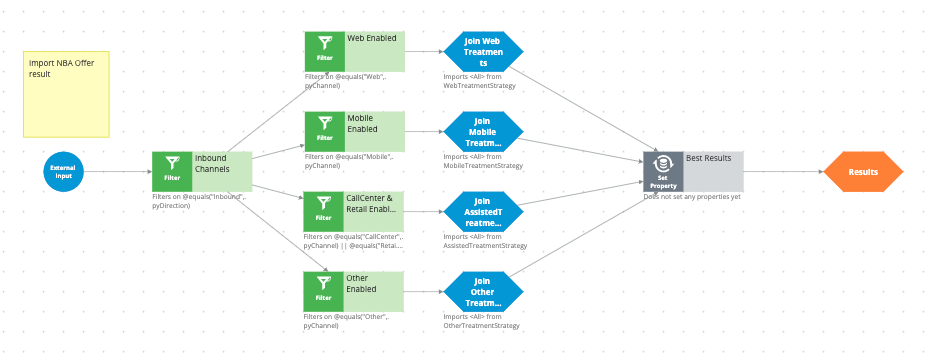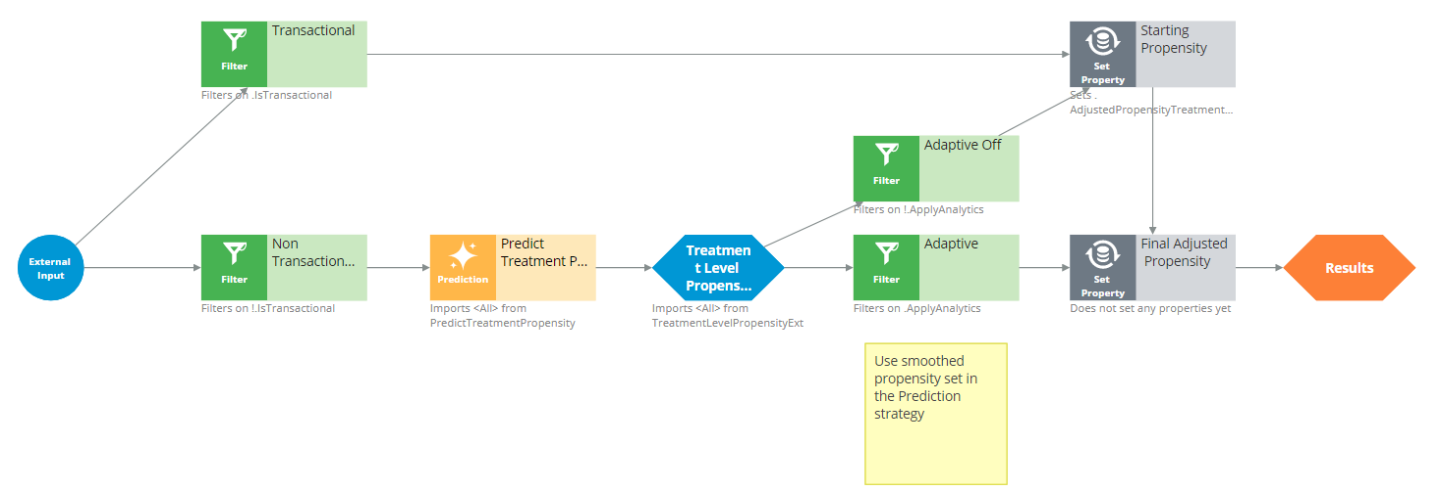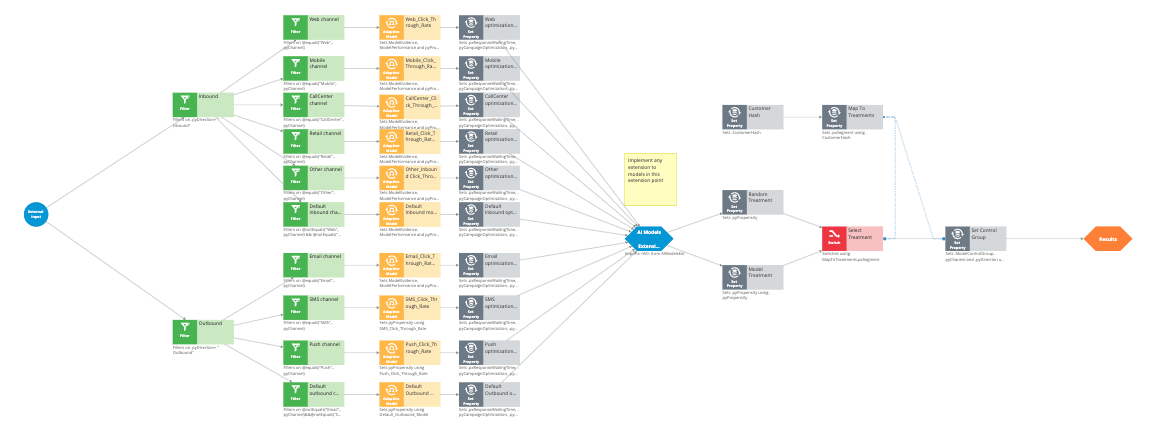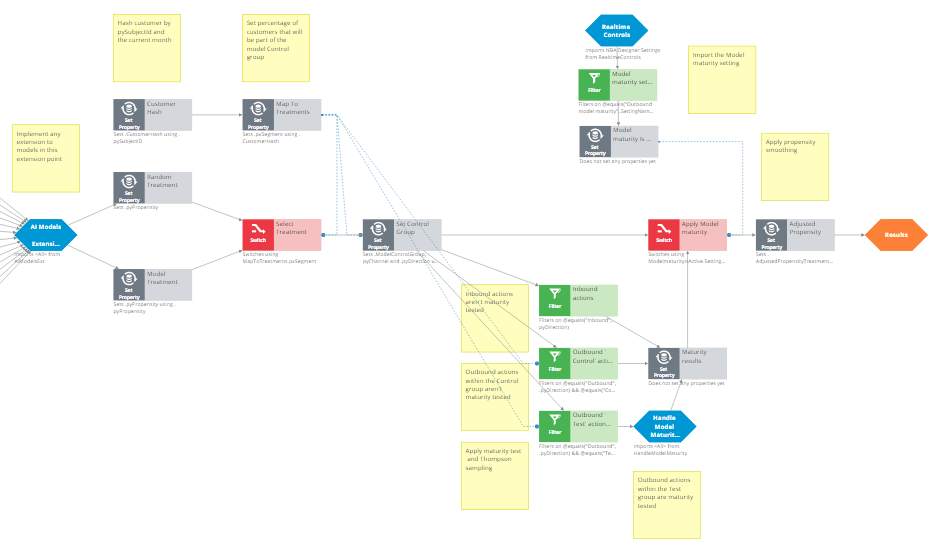Inbound channels
The InboundChannels sub-strategy links actions with the treatments for all of the inbound channels; a separate sub-strategy is called for each of Web, Mobile, Assisted (Call Center and Retail), and Other (custom channels).
This strategy only applies when the primary direction is inbound. The individual channels must also be active on each action.

Web treatment strategy
The WebTreatmentStrategy links actions with the treatments from the WebTreatmentsJoin DDR. As a result, pyTreatment value is set on the action.
The pyTreatment property is then used to access the WebTreatments library DDR and retrieve the metadata for the treatment (PlacementType, ImageURL, ContentFormat, ClickThroughURL). Individual metadata values that are defined at the treatment level will override their action-level equivalents.

Mobile treatment strategy
The MobileTreatmentStrategy links actions with the treatments from the MobileTreatmentsJoin DDR. As a result, pyTreatment value is set on the action.
The pyTreatment property is then used to access the MobileTreatments library DDR and retrieve the metadata for the treatment (PlacementType, ImageURL, ContentFormat, ClickThroughURL). Individual metadata values that are defined at the treatment level will override their action-level equivalents.

Assisted treatment strategy
This is a common strategy for both Inbound and Outbound and is described under the Outbound section.
Other treatments strategy
This is a common strategy for both Inbound and Outbound and is described under the Outbound section.
Treatment-level scoring strategy
The TreatmentLevelPropensity strategy is responsible for applying an adaptive model for each treatment and calculating the propensity across eligible channels.
Actions can be designated as transactional in nature, that is, they are always intended to be delivered and do not require any arbitration. Treatments for transactional actions are filtered out and bypass analytics processing.
Treatments for non-transactional actions are directed to the PredictTreatmentPropensity Prediction shape, and then to the TreatmentLevelPropensityExt extension point sub-strategy.

AI models strategy
The AIModels strategy uses the outcome optimization approach which provides a different model configuration and outcome for each channel. This strategy filters out treatments based on channel to ensure that the correct model is applied. As with the action level strategy, 2% of treatments are given a random propensity to ensure that the models have the opportunity to discover new patterns.

Finally, the treatments are divided into adaptive and non-adaptive streams based on the ApplyAnalytics property, and the non-Adaptive stream sets both the AdjustedPropensityTreatment and pyPropensity properties based on the action StartingPropensity, whereas for the Adaptive stream these values are calculated by the PredictTreatmentPropensity strategy.
Predict treatment propensity strategy
The PredictTreatmentPropensity prediction strategy uses the outcome optimization approach which provides a different model configuration and outcome for each channel. This strategy filters treatments based on channel to ensure that the correct model is applied. As with the action level PredictActionPropensity strategy, Random Control Group, Outbound Model Maturity, and Propensity Smoothing techniques are applied to optimize statistical robustness.
The strategy is shown below split into two sections for easier viewing; the first portion separates the treatments into inbound or outbound, and then further splits them based on channel before executing the appropriate Prediction strategy for the channel. They are then merged to the AIModelsExt extension point sub-strategy for any additional processing (if required) before proceeding to control group processing.

Each channel except for Paid has a separate Prediction strategy assigned which contains the actual reference to the adaptive model followed by some property settings, an example for the web channel is shown below (PredictWebPropensity).

The second portion of this strategy is ostensibly the same as the right portion of its Action equivalent, i.e. the PredictActionPropensity Prediction Strategy, where the Random Control Group, Outbound Model Maturity, and Propensity Smoothing processes are applied.

Previous topic Outbound channels Next topic Control Group Processing
